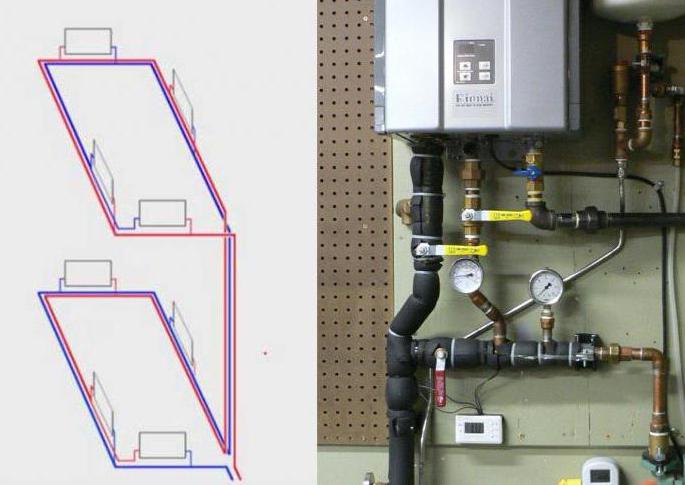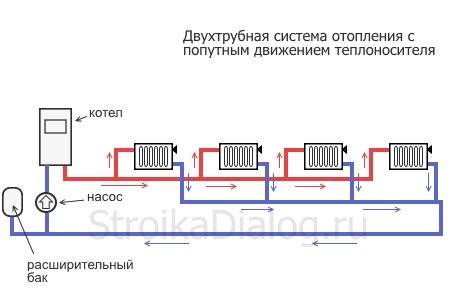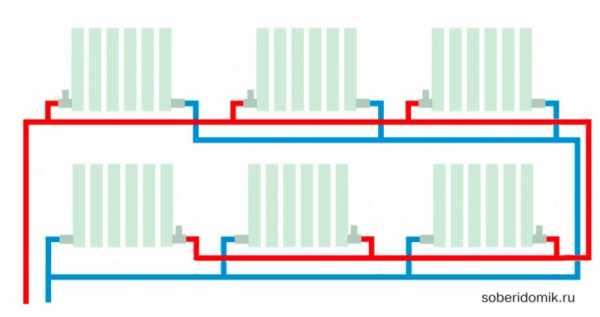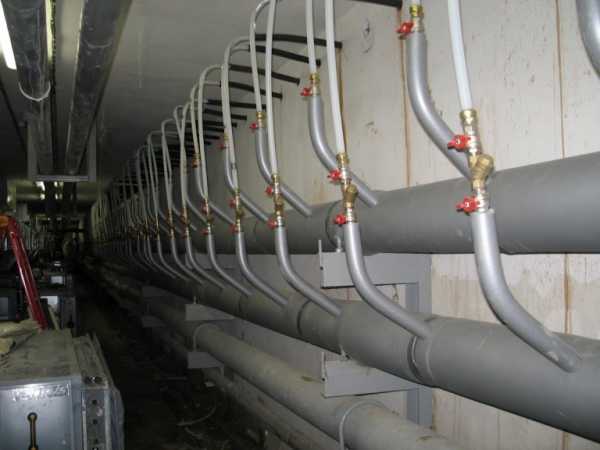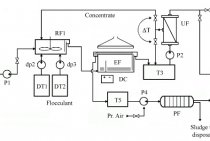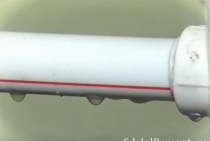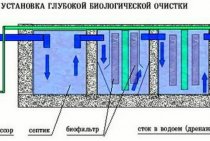The opinion of the owners of country houses about the system
According to most owners of suburban real estate, this scheme is really very effective - the Tichelman loop. Reviews such a system deserved just excellent. In the house, with its proper design and assembly, a very comfortable microclimate is established. At the same time, the system equipment itself rarely breaks down and lasts a long time.
Not only the owners of residential buildings, but also the owners of summer cottages speak well of the Tichelman loop. The heating system in such buildings during the cold season is often used irregularly. If the wiring is done according to a dead-end scheme, when the boiler is turned on, the rooms warm up extremely unevenly. With an associated system, such problems, of course, do not arise. But the assembly of heating according to such a scheme is really more expensive than according to a dead end.
Installation procedure
The work consists of the following operations:
- Boiler installation. The required minimum room height for its placement is 2.5 m, the allowable volume of the room is 8 cubic meters. m. The required power of the equipment is determined by calculation (examples are given in special reference publications). Approximately for heating 10 sq. m requires a power of 1 kW.
- Mounting of radiator sections. The use of biometric products in private homes is recommended. After selecting the required number of radiators, their location is marked (usually under window openings) and fastened with special brackets.
- Pulling the pipeline of the associated heating system. The use of metal-plastic pipes is optimal, which successfully withstand high temperature conditions, are distinguished by durability and ease of installation. The main pipelines (supply and “return”) from 20 to 26 mm and 16 mm for connecting radiators.
- Installation of a circulation pump. Mounted on the return pipe near the boiler. Tapping is done through a bypass with 3 taps. A special filter must be installed before the pump, which will significantly increase the life of the device.
- Installation of an expansion tank and elements ensuring the safety of the equipment. For a heating system with a passing movement of the coolant, only membrane expansion tanks are selected. Elements of the safety group are supplied with the boiler.
For tracing doorways in back rooms and utility rooms, it is allowed to mount pipes directly above the door. In this place, to prevent air accumulation, automatic air vents must be installed. In residential areas, pipes can be laid under the door in the body of the floor or bypassing the obstacle using a third pipe.
The Tichelman scheme for two-story houses provides for a certain technology. Piping is carried out with tying the entire building as a whole, and not each floor separately. It is recommended to install one circulation pump on each floor while maintaining equal lengths of return and supply pipelines for each radiator separately in accordance with the basic conditions of an associated two-pipe heating system. If you install one pump, which is quite acceptable, then if it fails, the heating system will turn off in the entire building.
Many experts consider it expedient to arrange a common riser on two floors with a separate piping on each floor. This will allow taking into account the difference in heat losses on each floor with the selection of pipe diameters and the number of required sections in radiator batteries.
A separate associated heating circuit on the floors will greatly simplify the system setup and allow for optimal balancing of the heating of the entire building. But to obtain the desired effect, it is necessary to insert a balancing crane into the trailing circuit for each of the two floors. Cranes can be placed side by side directly next to the boiler.
Tichelman loop for two floors or more
Most often, such a heating system is mounted in one-story buildings of a large area. It is in such houses that it works most effectively. However, sometimes such a system is also assembled in two-three-story buildings. When performing wiring in such houses, a certain technology should be followed. According to the Tichelman scheme, in this case, not each floor is tied up separately, but the entire building as a whole. That is, an equal sum of the lengths of the return and supply pipelines for each radiator of the house is maintained.
The Tichelman loop on two floors is thus assembled according to a special scheme. Also, experts believe that it is not advisable to use only one circulation pump in this case. If possible, it is worth installing one such device on each floor in the building. Otherwise, if a single pump breaks down, the heating will be turned off in the whole house at once.
Applications of the Tichelmann Loop
Increased material consumption is not always better, so the Tichelman system is rarely used in a two-story house. The exception is the line with the placement of radiators around the perimeter of the building. The ring system will require significant material costs, but the arrangement of a closed ring is carried out only if there are no obstacles in the form of doorways, floor-to-ceiling windows. You will have to lay another line to return the coolant to the heating device.
If the loop is lengthened, moved away from the heater, the pipe section is increased or a powerful circulation pump is selected, otherwise the system will not be able to work at full capacity.
To reduce the flow of coolant in the connection area of the first batteries, the diameter of the pipeline should be reduced, this will help maintain water pressure in subsequent sections. The diameter reduction is carried out only according to preliminary calculations, otherwise the radiators, which are at a considerable distance from the heating device, will not receive the coolant in sufficient volume.

It turns out that it is possible to use two-pipe wiring with a passing water flow only with a total length of the main line from 70 meters, on which 10 radiators are installed. Otherwise, passing wiring will not justify the investment.
What is a Tichelman loop
The Tichelman loop (also called the "passing scheme") is a scheme for piping the heating system. Such a scheme simultaneously combines the advantages of two common schemes: Leningrad and two-pipe, while having additional advantages.
Compared with the two-pipe scheme, when using the Tichelmann loop, there is no need to install expensive adjustment systems. The heaters work like one big radiator. The coolant flow is the same throughout the heating circuit. There are no narrowing pipes and dead-end radiators, in which the flow is the worst. The disadvantage in comparison with a two-pipe heating scheme is that it is necessary to make the entire branch with a large diameter pipe, which can greatly affect the cost of the entire system as a whole.
If compared with the Leningrad (single-pipe) scheme, the advantage is that the coolant will not pass through the pipe past the radiator. The Leningrad scheme is very demanding on the design of the scheme and installation. With a low qualification of performing either the first or second, it will be impossible to force water to pass through the heater, it will pass through the pipe. The radiator will remain slightly warm.In addition, in the Leningrad scheme, the first radiators in terms of water flow will be hotter than the next. Since the water will reach them already chilled. The disadvantage of the Tichelman loop compared to the "Leningrad" loop is an increase in pipe consumption by almost 2 times.
Of the general advantages, I would like to note that such a scheme is difficult to unbalance. The conditions for the movement of the coolant are almost ideal, which, moreover, has a positive effect on the operation of the heat generator (whether it be a boiler, solar systems or something else).
The main disadvantage of the associated heating scheme is certain requirements for the premises. In practice, it is not always possible to organize a circular motion of the coolant. Doorways, architectural features, etc. may interfere. In addition, it can only be used for horizontal wiring, with a vertical Tichelman loop is not applicable.
Traditionally used heating schemes
- Single pipe. The circulation of the heat carrier is carried out through one pipe without the use of pumps. Radiator batteries are connected in series on the main line, from the last one the cooled carrier returns to the boiler through the pipe (“return”). The system is simple to implement and economical due to the need for fewer pipes. But the parallel movement of flows leads to a gradual cooling of the water, as a result, the carrier arrives at the radiators located at the end of the series chain significantly cooled. This effect increases with an increase in the number of radiator sections. Therefore, in rooms located near the boiler, it will be excessively hot, and in remote ones it will be cold. To increase heat transfer, the number of sections in the batteries is increased, different pipe diameters are installed, additional control valves are installed, and each radiator is equipped with bypasses.
- Two-pipe. Each radiator battery is connected in parallel to the pipes for the direct supply of hot coolant and the “return”. That is, each device is equipped with an individual output to the “return”. With the simultaneous discharge of cooled water into the common circuit, the coolant returns to the boiler for heating. But at the same time, the heating of heating devices also gradually decreases as they move away from heat sources. The radiator located first in the network receives the hottest water and is the first to give the carrier to the “return”, and the radiator located at the end receives the coolant last with a lower heating temperature and also the last to give water to the return circuit. In practice, in the first device, the circulation of hot water is the best, and in the last, the worst. It is worth noting the increased price of such systems compared to single-pipe ones.
Both schemes are justified for small areas, but are inefficient for extended networks.
An improved two-pipe is the Tichelman heating scheme. When choosing a specific system, the availability of financial opportunities and the ability to provide the heating system with equipment that has the optimal required characteristics is decisive.
Tichelman heating feature
The idea of changing the principle of operation of the "return" was justified in 1901 by the German engineer Albert Tichelman, after whom it got its name - the "Tichelmann loop". The second name is “reverse type return system”. Since the movement of the coolant in both circuits, supply and return, is carried out in the same direction, a third name is often used - “scheme with the associated movement of heat carriers”.
The essence of the idea is the presence of the same length of straight and reverse pipe sections connecting all radiator batteries with a boiler and a pump, which creates the same hydraulic conditions in all heating devices.Circulation circuits of equal length create conditions for the hot coolant to pass the same path to the first and last radiators with the same heat energy being received by them.
Tichelman loop diagram:
Heating circuit with Tichelman loop pros and cons
Two-pipe heating systems of a private house, as a rule, are dead-end systems, which leads to the fact that in the last radiator, due to the greatest distance, the pressure and flow of the coolant are weaker, respectively, the heater heats worse. This problem is solved by increasing the number of radiator sections or adding regulators to each radiator.
The second solution, which is used when installing two-pipe heating systems for a private house, is balancing the system.
Tichelman's scheme is quite simple. In the classic two-pipe scheme, the return heating main starts from the last radiator and ends with the boiler, and the supply starts from the boiler and ends with the last radiator.
The features of the Tichelman loop are that the “return” starts from the first radiator, reaches the last one and returns to the boiler, and the supply, as in the classical scheme, starts from the boiler and ends with the last radiator.
It turns out that the first radiator from the boiler is the first on the supply and the last on the return, respectively, the last radiator is the last on the supply, but the first on the return.
This is a kind of direct-flow system in which the coolant in the supply and return heating mains moves in the same direction.
This scheme allows you to provide uniform resistance and flow in two-pipe systems.
Advantages and disadvantages of the Albert Tichelmann loop
Two-pipe heating systems for a private house, which were installed according to the Tichelman scheme, have the advantages of direct-flow single-pipe systems (“Leningradka”) and two-pipe systems, as well as a number of additional advantages.
First of all, we note the balance of the system and the absence of the need to install various adjustment equipment, which is quite expensive.
At the same time, the coolant flow throughout the system is the same, and the operation of heat-generating equipment is optimal and has a high efficiency.
The disadvantages of the Tichelman scheme include the need to use additional pipes and preferably a large diameter, and these are additional costs.
Moreover, the architectural features of a private house do not always allow the installation of an open heating system with three pipes. For example, doorways and a number of other architectural forms can interfere with the installation of a heating system of this type.
Therefore, it is not always possible to organize a circular movement of the intermediate coolant in a two-pipe heating system of a private house.
We also note that in most cases, when installing return heating systems of a reversible type according to the Tichelman scheme, horizontal wiring is used.
In terms of other characteristics and the heating equipment and heat generators used, the Tichelman loop does not differ from its two-pipe counterparts.

